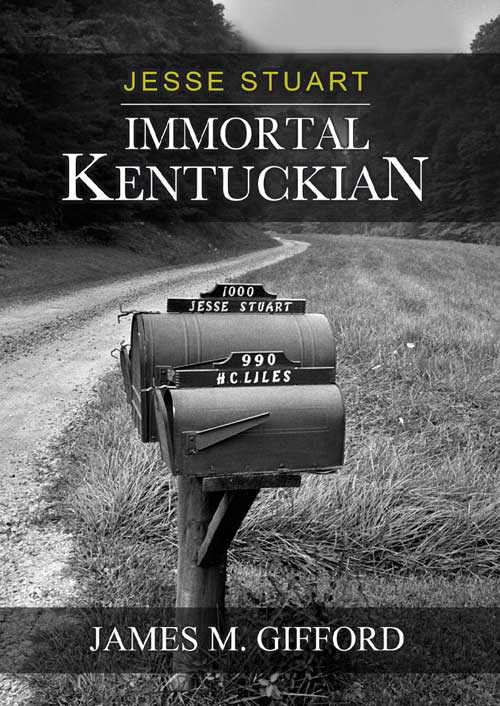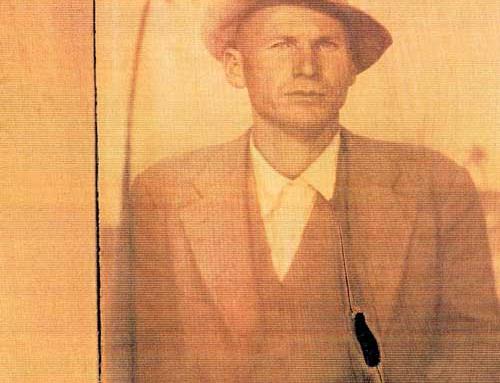The late Poet Laureate of Kentucky, Jesse Hilton Stuart, published 2,000 poems, 460 short stories, and more than 60 books. He was one of Appalachia’s best known and most anthologized authors, and his works have been translated into many foreign languages. In 1976, eight years before his death, the editors of Country Gentleman magazine boldly proclaimed that Jesse Stuart was “America’s most famous chronicler of rural life.”
Yet his contributions are more than literary. During his life, this world-famous educator and charismatic author served as a leader for the people of his mountain homeland and as a spokesman for values like hard work, respect for the land, belief in education, devotion to country, and love of family. His life and works still attract hundreds of tourists to eastern Kentucky every year. Jesse became a far-sighted conservationist – donating over 700 acres of his land in W-Hollow to the Kentucky Nature Preserve System in 1980.
 Jesse Stuart was born on August 8, 1906, in northeastern Kentucky’s Greenup County, where his parents, Mitchell and Martha (Hilton) Stuart, were impoverished tenant farmers. Mitchell and Martha Hilton Stuart taught their children an intensely adversarial communication style. Jesse’s brother James once said, “We fight among ourselves like cats and dogs, but if you get cross ways with one of us, we’ll all jump on you.”
Jesse Stuart was born on August 8, 1906, in northeastern Kentucky’s Greenup County, where his parents, Mitchell and Martha (Hilton) Stuart, were impoverished tenant farmers. Mitchell and Martha Hilton Stuart taught their children an intensely adversarial communication style. Jesse’s brother James once said, “We fight among ourselves like cats and dogs, but if you get cross ways with one of us, we’ll all jump on you.”
Jesse graduated from Greenup County High School in 1926 and from Lincoln Memorial University in Harrogate, Tennessee, in 1929. He then returned to Greenup County to teach.
By the end of the 1930s, Stuart had served as a teacher in Greenup County’s one-room schools and as high school principal and county school superintendent. These experiences served as the basis for his autobiographical book, “The Thread That Runs So True” (1949), hailed by Dr. J. Elmer Morgan, founder and president of the National Education Association, as “the best book on education written in the last 50 years.” The book became a road map for educational reform in Kentucky. By the time it appeared, Stuart had left the classroom to devote his time to lecturing and writing.
Stuart began writing stories and poems about Appalachia in high school and college. During a year of graduate study at Vanderbilt University in 1931-32, Donald Davidson, one of his professors, encouraged him to continue writing. “Man With a Bull-Tongue Plow” appeared in 1934 and was widely praised by reviewers and general readers. Mark Van Doren, for instance, likened Stuart to Robert Burns as a poet “who captured the heart and soul of his people.”
Stuart began his autobiographical “Beyond Dark Hills” while he was at Vanderbilt. Published in 1938, it inspired readers to follow Stuart’s example of overcoming great obstacles to obtain an education. “Head o’ W-Hollow” (1936) and “Men of the Mountains” (1941) were followed by more than a dozen Stuart short story collections which appeared in his lifetime.
He was also a widely-read novelist, and critics such as J. Donald Adams ranked Stuart as a first-class local colorist. Stuart was a also successful poet. His ten volumes of verse include “Album of Destiny” (1944) and “Kentucky Is My Land” (1952). He was designated as the Poet Laureate of Kentucky in 1954 and was made a fellow of the Academy of American Poets in 1961.
Throughout his adult life, Stuart received numerous honors as a writer and educator. In 1944, the University of Kentucky awarded him his first of sixteen honorary doctorates. In 1981, he received Kentucky’s Distinguished Service Medallion.
Stuart was disabled by a stroke in 1978, and a few years later, in May 1982, he suffered another stroke, which rendered him comatose until he died on February 17, 1984. He is buried in Plum Grove Cemetery in Greenup County, close to W-Hollow, the little Appalachian valley that became a part of the American imagination through his world-famous books.
I have made Jesse’s voice a prominent part of this biography, utilizing hundreds of Stuart letters which were not available to previous Stuart scholars.
“Jesse Stuart: Immortal Kentuckian” presents an overview of the broad range of Stuart’s accomplishments as an author, educator, conservationist, spokesman for Kentucky and Appalachia, compulsive correspondent, world traveler, father, husband, and community-minded neighbor. This book presents a character study of one of the most significant individuals in Appalachian history.
A new softcover edition of “Jesse Stuart: Immortal Kentuckian” is available from the Jesse Stuart Foundation at 4440 13th Street in Ashland.
By James M. Gifford
JSF CEO & Senior Editor
Jesse Stuart: Immortal Kentuckian
The late Poet Laureate of Kentucky, Jesse Hilton Stuart, published 2,000 poems, 460 short stories, and more than 60 books. He was one of Appalachia’s best known and most anthologized authors, and his works have been translated into many foreign languages. In 1976, eight years before his death, the editors of Country Gentleman magazine boldly proclaimed that Jesse Stuart was “America’s most famous chronicler of rural life.”
Yet his contributions are more than literary. During his life, this world-famous educator and charismatic author served as a leader for the people of his mountain homeland and as a spokesman for values like hard work, respect for the land, belief in education, devotion to country, and love of family. His life and works still attract hundreds of tourists to eastern Kentucky every year. Jesse became a far-sighted conservationist – donating over 700 acres of his land in W-Hollow to the Kentucky Nature Preserve System in 1980.

Jesse Stuart was born on August 8, 1906, in northeastern Kentucky’s Greenup County, where his parents, Mitchell and Martha (Hilton) Stuart, were impoverished tenant farmers. Mitchell and Martha Hilton Stuart taught their children an intensely adversarial communication style. Jesse’s brother James once said, “We fight among ourselves like cats and dogs, but if you get cross ways with one of us, we’ll all jump on you.”
Jesse graduated from Greenup County High School in 1926 and from Lincoln Memorial University in Harrogate, Tennessee, in 1929. He then returned to Greenup County to teach.
By the end of the 1930s, Stuart had served as a teacher in Greenup County’s one-room schools and as high school principal and county school superintendent. These experiences served as the basis for his autobiographical book, “The Thread That Runs So True” (1949), hailed by Dr. J. Elmer Morgan, founder and president of the National Education Association, as “the best book on education written in the last 50 years.” The book became a road map for educational reform in Kentucky. By the time it appeared, Stuart had left the classroom to devote his time to lecturing and writing.
Stuart began writing stories and poems about Appalachia in high school and college. During a year of graduate study at Vanderbilt University in 1931-32, Donald Davidson, one of his professors, encouraged him to continue writing. “Man With a Bull-Tongue Plow” appeared in 1934 and was widely praised by reviewers and general readers. Mark Van Doren, for instance, likened Stuart to Robert Burns as a poet “who captured the heart and soul of his people.”
Stuart began his autobiographical “Beyond Dark Hills” while he was at Vanderbilt. Published in 1938, it inspired readers to follow Stuart’s example of overcoming great obstacles to obtain an education. “Head o’ W-Hollow” (1936) and “Men of the Mountains” (1941) were followed by more than a dozen Stuart short story collections which appeared in his lifetime.
He was also a widely-read novelist, and critics such as J. Donald Adams ranked Stuart as a first-class local colorist. Stuart was a also successful poet. His ten volumes of verse include “Album of Destiny” (1944) and “Kentucky Is My Land” (1952). He was designated as the Poet Laureate of Kentucky in 1954 and was made a fellow of the Academy of American Poets in 1961.
Throughout his adult life, Stuart received numerous honors as a writer and educator. In 1944, the University of Kentucky awarded him his first of sixteen honorary doctorates. In 1981, he received Kentucky’s Distinguished Service Medallion.
Stuart was disabled by a stroke in 1978, and a few years later, in May 1982, he suffered another stroke, which rendered him comatose until he died on February 17, 1984. He is buried in Plum Grove Cemetery in Greenup County, close to W-Hollow, the little Appalachian valley that became a part of the American imagination through his world-famous books.
I have made Jesse’s voice a prominent part of this biography, utilizing hundreds of Stuart letters which were not available to previous Stuart scholars.
“Jesse Stuart: Immortal Kentuckian” presents an overview of the broad range of Stuart’s accomplishments as an author, educator, conservationist, spokesman for Kentucky and Appalachia, compulsive correspondent, world traveler, father, husband, and community-minded neighbor. This book presents a character study of one of the most significant individuals in Appalachian history.
A new softcover edition of “Jesse Stuart: Immortal Kentuckian” is available from the Jesse Stuart Foundation at 4440 13th Street in Ashland.
By James M. Gifford
JSF CEO & Senior Editor




